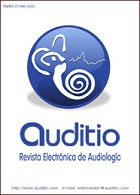Quantitative and qualitative evolution of presbycusis in patients with hearing aids
DOI:
https://doi.org/10.51445/sja.auditio.vol5.2019.0061Keywords:
presbyacusis, hearing loss, hearing aid, intelligibility, hearing aid fitting, hard of hearing, hearing deviceAbstract
Introduction. Presbycusis is a disease of multifactorial origin that affects the ear and therefore the life of the patient who suffers it, generating alterations in oral communication and social isolation, depression and even dementia.
Aim. The objective of this study is to analyze the influence of the use or not of hearing aids on the evolution of hearing thresholds as well as on the preservation of intelligibility in a sample of presbycusic patients in the Tarazona and Moncayo regions.
Material and methods. The sample consists of 75 patients (44 men and 31 women) aged between 50 and 92 years, who have undergone an initial review and at least one follow-up within a period of more than 2 years and less than 4 years. In each review, the following were performed: anamnesis (in the initial review), tonal audiometry and speech audiometry. All tests are carried out in the same center by a single examiner.
Results. In the sample of presbycusic patients analyzed, it cannot be affirmed that the use of hearing aids prevents the deterioration of hearing thresholds. However, its use has a positive effect on the preservation of oral language comprehension skills, more accentuated in users with symmetric hearing losses and binaural adaptation.
Discussion. This is a population sample circumscribed in a rural geographical area. The treatment for presbycusis is advisable to make a binaural adaptation from the first systems and diagnosis of the hearing impairment to maintain oral communication and prevent the consequences of social isolation.
Downloads
Visibility and Altmetrics
Metrics
Global Statistics ℹ️
|
1825
Views
|
2507
Downloads
|
|
4332
Total
|
|
References
American Medical Association. (1998). Evaluation of hearing handicap. The American Academy of Otolaryngology and American Council of Otolaryngology (AA0-ACO), J. AM Acad Audiology
Anderson, S., Kraus, N. (2013). Auditory Training: Evidence for Neural Plasticity in Older Adults. Perspectives on Hearing and Hearing Disorders. Research and Research Diagnostics. 17: 37-57. https://doi.org/10.1044/hhd17.1.37
Benavides, M., Peñaloza-López, Y., De la Sancha-Jimenez, S., García F., Gudiño, P.K. (2007). Lateralidad auditiva y corporal, logoaudiometría y ganancia del audífono monoaural. Aplicación en hipoacusia bilateral simétrica. Acta Otorrinolaringología España. 58(10): 458-63. https://doi.org/10.1016/S0001-6519(07)74967-1
Boboshko, M.Y., Golovanova, L.E., Zhilinskaia, E.V., Ogorodnikova, E.A. (2017). The effectiveness of hearing aids in elderly people. Advances in Gerontology. Russian. 30(1): 114-120.
Byrne, D., Dillon, H., Ching, T., Katsch, R., Keidser, G. (2001). NAL-NL1 procedure for fitting non lineal hearing aids characteristics and comparisons with other procedures. Journal of the American Academy of Audiology. 12(1): 37-51.
Canina, M.M., Zilioto, K., Desgualdo, L. (2012). Acoustic stimulation effect on temporal processing skills in elderly subjetct before and after hearing aid fitting. Brazilian Journal of Otorrinolaryngology, Disponible en: www.bjorl.org
Carreño F. (2014). Ayudas Técnicas. Soc. Española de Otorrinolaringología y Patología Cérvico Facial. 307-323
Ciorba, A., Bianchini, Ch., Peluchi, S., Pastore, A. (2010). The impact of hearing loss on the quality of life of elderly adults. Clin. Intervention Aging. 7: 159-163. https://doi.org/10.2147/CIA.S26059
Fischer, N., Weber, B., Riechelmann, H. (2016). Presbycusis- Age Related Hearing Loss. Laryngorhinootologie. 95(7): 497-510. 10. Frisina, R.D., Ding, B., Zhu X, Walton JP. (2016). Age Related Hearing Loss: Prevention of threshold declines, cell loss and apoptosis in spiral ganglion neurons. Rev. Aging-us, Albany NY. 2016. 8(9): 2081-2099. https://doi.org/10.18632/aging.101045
Fortunato, S., Forli, F., Gugliemlmi, V., de Corso, E., Paludetti, G., Berrettini, S., Fetori, A.R. (2016). A review of new insights on the association between hearing loss and cognitive decline in aching. Acta Otorhinolaryngol Italy. 36(3):155-66
García, F.J., García Callejo, N., Conill, T, Ramírez, S. (2006). Estudio Preliminar, Efecto de la supresión del tabaco en la hipoacusia. España. Hospital Universitario de Valencia. Acta Otorrinolaringología España. 57(9): 432-4. https://doi.org/10.1016/S0001-6519(06)78743-X
Gates, G.A., Cooper J.C.Jr., Kannel W.B., Miller N.J. (1990). Hearing in the elderly: the Framingham cohort, 1983-1985. Part I. Basic audiometric test result. Ear Hear. 11:247-256 https://doi.org/10.1097/00003446-199008000-00001
Gates, G.A., Couropmitree, M.P.H., Myers, R.H. (1999). Genetic Associations in age-related hearing thresholds. Arch. Otolaryngology Head-Neck Surg. 125(6): 654-659. https://doi.org/10.1001/archotol.125.6.654
Giraud, N., Lemke, U., Reich, P., Matthes, K.L, Meyers, M. (2017). The impact of hearing aids and age-related hearing loss on auditory plasticity across three months. Hearing Research. 353: 162-175. https://doi.org/10.1016/j.heares.2017.06.012
Guinan, J.J., Salt, A., Cheetham, M.A. (2012). Progress in cochlear physiology after von Békésy. Hearing Research. 293(1-2): 12-20. https://doi.org/10.1016/j.heares.2012.05.005
Hearing Aid Industry Association, (1961), [internet] [consultado: oct-2017] Hearing aid industry repport. Disponible en: www. hearing.org 18. Hedestierna C, Rosenhall U. (2016). Age-related hearing decline in individuals with and without occupational noise exposure. Noise and Health. 18(80): 21-25. https://doi.org/10.4103/1463-1741.174375
Herrero, M., Thuissard, J., Sanz-Rosa, D., Ruiz, C., Vidal, J., Domínguez, S.V. (2016). Negligencia auditiva en pacientes con enfermedad de Alzheimer. Auditio: Revista Electrónica de Audiología. 4(3): 63-66. https://doi.org/10.51445/sja.auditio.vol4.2018.0057
Hewitt D. (2017). Age-Related Hearing Loss and Cognitive Decline: You Haven't Heard the Half of It. Front. Aging Neuroscience. 9:112. https://doi.org/10.3389/fnagi.2017.00112
Homans, C., Metselaar, R.M., Dingemanse, J.G,, Schoroeff, M.P., Brocaar, M.P., Wieringa, M.H., Bratenburg de Jong, R.S., Hofman, A., Goedegebure, A. (2017). Prevalence of age-related hearing loss, including sex differences in older adults in a large cohort study. Laryngoscope. 127(3): 725-730. https://doi.org/10.1002/lary.26150
Hornickel J., Skoe E., Kraus N. (2009). Subcortical laterality of speech encoding. Audiology Neurootol. 14(3): 198-207 https://doi.org/10.1159/000188533
Instituto Aragonés de Estadística, Estadística local de Aragón. Ficha Territorial. Comarca de Tarazona y el Monayo (2017). [internet],[consultado ene-2018]. Disponible en www.aragon.es
Izquierdo M.A., Oliver D.L., Malmierca M.S. (2009), Mecanismos de plasticidad (funcional y dependiente de actividad) en el cerebro auditivo adulto y en desarrollo). Rev. Neurology. 16; 48(8): 421-429. https://doi.org/10.33588/rn.4808.2009038
Kang, J.W., Choi, H.S., Kim, K., Cjoy, J.Y. (2014). Dietary vitamin intake correlates with hearing thresholds in older population. The Koeran Health and nutrition examination survey. American Society of Nutrition. 99(6): 1407-13. https://doi.org/10.3945/ajcn.113.072793
Karawani, H., Bitan, T., Attias, J., Banai, K. (2016). Auditory Perceptual Learning in Adults with and without. Age-Related Hearing Loss. Frontiers in Psychology. 6: 1-16. Articulo 2066. https://doi.org/10.3389/fpsyg.2015.02066
Kyu-Yup, L. (2013). Patophysiology of age-related hearing loss (Peripheral and Central). Koeran Journal of Audiology. 17(2): 45-9. doi: 10.7874/kja.2013.17.2.45 https://doi.org/10.7874/kja.2013.17.2.45
Lang H., Jyothi V., Smythe N.M., Dubno J.R., Schutle B.A., Schmiedt R.A. (2010). Chronic Reduction of Endocochlear Potential Reduces Auditory Nerve Activity: Further Confirmation of an Animal Model of Metabolic Presbyacusis". Journal of Association Research in Otolaryngology. 11(3): 419-434. https://doi.org/10.1007/s10162-010-0214-7
Leensen, M.C.S., van Duivenbooden, J.C., Dreschler, W.A. (2011). A retrospective analysis of noise-induced hearing loss in the Dutch construction industry. International Archives of Occupational and Environmental Health. 84(15): 577-590. https://doi.org/10.1007/s00420-010-0606-3
Lin, F.R. (2011). Hearing loss and cognition among older adults in the United States. The Journals of Geontology. 66(10): 131-6. https://doi.org/10.1093/gerona/glr115
Lin, A., Skogstad, M., Johannessen, H.A., Tynes, T., Mehlum, I.S., Nordby, K.C., Engdahl, B., Tambs, K. (2105). Occupational noise exposure and hearing: a systematic review. International Archives of Occupational and Environmental Health, 89: 351-372. https://doi.org/10.1007/s00420-015-1083-5
Lin, B.M., Curhan, S.G., Wang, M., Eavey, R., Stankovic, K.M., Curhan, G.C. (2016). Hypertension, Diuretic Use, and Risk of Hearing Loss. The American Journal of Medicine. 129(4): 416-22. https://doi.org/10.1016/j.amjmed.2015.11.014
Martins J.H., Costa M., Sousa S. (2014). Sistemática de la evaluación del Procesamiento Auditivo Central", Sociedad española de otorrinolaringología y patología cérvico facial. 241-257
Michaud, H.N., Duchesne, L. (2017). Aural Rehabilitation of older adults with hearing loss: Impact on quality of life, a systematic review of randomized controlled trials. Journal Academy of Audiology. 28(7): 596-609. https://doi.org/10.3766/jaaa.15090
Mills, D., Schmiedt, R.A. (2004). Metabolic Presbycusis: Differential Changes in Auditory Brainstem and Otoacustic Emission Responses with Chorinic Furosemide Application in the Gerbil. Journal of the Association of Research in Otolaryngology. 5(1): 1-10. https://doi.org/10.1007/s10162-003-4004-3
Moore, B. (2016). A review of the perceptual effects of hearing loss in frequencies above 3KHz, International journal of audiology. 55:12; 707-714 https://doi.org/10.1080/14992027.2016.1204565
Moscicki E.K., Elkins E.F., Baum H.M., McNamara P.M. (1985). Hearing loss in the elderly: an epidemiologic study of the Framingham Heart Study Cohort. Ear and Hearing. 6(4): 184-190 https://doi.org/10.1097/00003446-198507000-00003
Museik, F.E,, Shin, J.B., Jirsa, R., Bamiou, D.E., Baran, J.A., Zaida, E. (2005). GIN (gaps in noise) test performance in subjetcts with confirmed central auditory nervous system involvement. Ear and Hearing. 26(6): 608-18. https://doi.org/10.1097/01.aud.0000188069.80699.41
Naz, S., Imtiaz, A., Mujtaba, G., Maqsoud, A., Bashir, R., Bukhari, I., Khan, M.R., Friedman, T.B. (2016). Genetic causes of moderate to severing hearing loss point to modifiers. Clinical Genetics. 91(4): 589-598 https://doi.org/10.1111/cge.12856
Olson, A.D. (2015). Options for Auditory Training for Adults with Hearing Loss. Seminars in Hearing. 36(4): 284-95. https://doi.org/10.1055/s-0035-1564461
Penha, L., Rabelo, C.M., Ferreira, I., Rodrigues, R., Giannella, A. (2015). Interaction between diabetes mellitus and hypertension on hearing of elderly. Communication disorders, Audiology and Swallowing Journal (CoDAS).27(5): 42-32. Online version ISSN 2317-1782.
Poruyaghoub, G., Mehrdad, R., Pourhosein, S. (2016). Noise induced hearing loss among professional musicians. Journal of Occupational Health. 20.59(1): 33-37. https://doi.org/10.1539/joh.16-0217-OA
Russ, D., Robinson, M.S. (2011). Beltone's Adaptive Fitting Algorithm: Combining Loudness Normalization and Loudness Equalization to Achieve Target Gain. [internet], [consultado: oct-2017]. Disponible en: https://www.audiologyonline.com/articles/beltones- adaptive-fitting-algorithm-1206
Shanks J.E, Wilson R.H., Larson V, Williams D. (2002). Speech recognition performance of patients with sensorineural hearing loss under unaided and aided condition using linear and compression hearing aids. Ear Hear. 23(4): 280-290. https://doi.org/10.1097/00003446-200208000-00003
Someya, S., Prolla, T.A. (2010). Mitochondrial oxidative damage and apoptosis in age-related hearing loss. Mechanism of Ageing and Development: 131(7-8): 840-846. https://doi.org/10.1016/j.mad.2010.04.006
Sulkowski, W.S., Szymezak, W., Kowalska, S., Sward-Mtyja, M. (1981). [internet],[consultado: ene-2017], Epidemiology of occupational noise induced hearing loss in Poland. The Polish Otoryngology. The Polish otolaringology. 32(1): 9-16, Disponible: www. europepmc.org
Tadros, S.F., Frisina, S.T., Mape, F., Frisina, R. D., Frisina, R.D. (2005). Higher serum aldosterone correlates with lower hearing thresholds: A possible protective hormone against presbycusis. Hearing Research. 209: 10-18. https://doi.org/10.1016/j.heares.2005.05.009
Tang, X., Zhu, X., Ding, B., Walton, J.P., Frisina, Su, J. (2014). Age related hearing loss: GABA, nicotinic acetylcholine and NMDA receptor expression changes in spiral ganglion neurons of the mouse. Neuroscience. 14; 259: 184-93. https://doi.org/10.1016/j.neuroscience.2013.11.058
Teng, Z., Tian, R., Xing, F., Tang, H., Xu, J., Zhang, B., Qi, J. (2017). An association of type 1 diabetes mellitus with auditory dysfunction: A systematic review and meta‐analysis. The Laryngoscope. 127(7): 1689-1697 https://doi.org/10.1002/lary.26346
World Health Organization (WHO). Prevention of Blindness and Deafness. (2012). [internet],[consultado: oct-2017]. Hearing loss in persons 65 years and older based on WHO global estimates on prevalence of hearing loss. Disponible en: http://www.who.int/ pbd/deafness/news/GE_65years.pdf
Zenker, F., Barajas, J.J. (2003) Las funciones auditivas centrales. Auditio: Revista Electrónica de Audiología. 2: 31-41. https://doi.org/10.51445/sja.auditio.vol2.2003.0025
Zenker, F., Suárez, M., Marro, S., Barajas de Prat, J.J. (2007). La evaluación del procesamiento auditivo central: Test de dígitos dicóticos". AELFA. (27): 74-85. https://doi.org/10.1016/S0214-4603(07)70076-1

Downloads
Published
Versions
- 2021-09-15 (2)
- 2018-02-13 (1)
How to Cite
Issue
Section
License
Copyright (c) 2018 Asociación Española de Audiología

This work is licensed under a Creative Commons Attribution 3.0 Unported License.
All articles will be published under the open Creative Commons Attribution (CC-BY) license. This license allows others to share and adapt the content, even for commercial purposes, as long as appropriate credit is given to the authors and the journal. By submitting their manuscript, authors retain copyright but grant the journal the right to make the first publication under this license.
More information about this license is available at: https://creativecommons.org/licenses/by/4.0/
Articles published between 2001 and 2020
The texts published in this journal in the section "AUDITIO 2001-2020" are subject - unless otherwise indicated - to a Creative Commons Attribution 3.0 Spain license. You can copy, distribute, communicate them publicly, make derivative works and commercial uses provided that you acknowledge the credits of the works (authorship, name of the journal, publishing institution) in the manner specified by the authors or by the journal. The full license can be consulted at http://creativecommons.org/licenses/by/3.0/es/deed.es.









